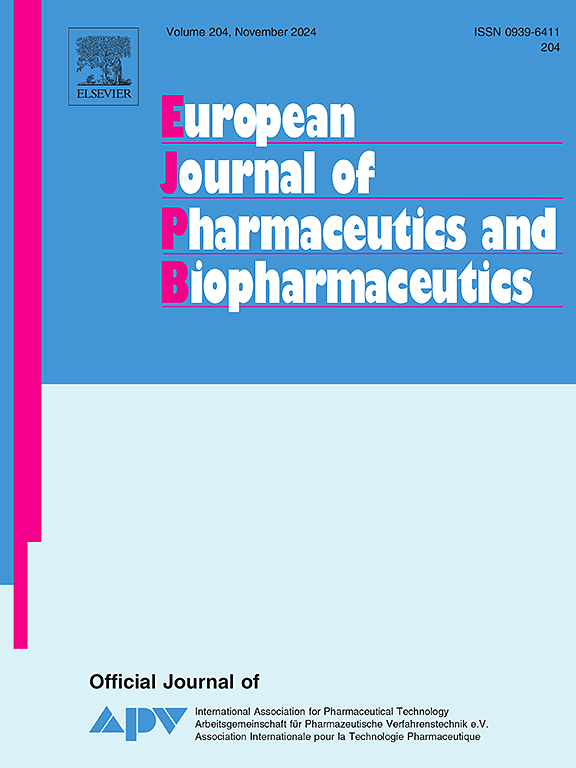靶向真菌性角膜炎:角膜靶向和非靶向肽对二角镰刀菌的体内疗效
IF 4.3
2区 医学
Q1 PHARMACOLOGY & PHARMACY
European Journal of Pharmaceutics and Biopharmaceutics
Pub Date : 2025-06-17
DOI:10.1016/j.ejpb.2025.114793
引用次数: 0
摘要
真菌性角膜炎是全球单眼失明的主要原因。这是因为,由于这些抗真菌剂的渗透性差和抑菌性,传统局部治疗的应用效果不佳。具有有效抗真菌作用的细胞穿透肽(CPPs)可能为解决这些挑战提供了解决方案。本研究评估了两种CPPs的抗真菌效果:角膜靶向肽(CorTS 1)和非靶向肽(Tat2)。在体外实验中,两种多肽均通过调节膜透性来有效抑制二角镰刀菌菌丝的生长。此外,与市售的纳他霉素眼用混悬液相比,这些肽在小鼠镰刀菌性角膜炎模型中表现出成功的跨上皮渗透,并表现出更好的治疗效果。虽然Tat2显示出更强的抗真菌效力,但其非特异性靶向和抗炎特性表明其在早期真菌性角膜炎中的潜在效用。相比之下,具有角膜靶向能力的CorTS 1可能更有效地治疗晚期深间质角膜炎。这些发现突出了具有生物活性的CPPs作为真菌性角膜炎的新疗法的潜力。本文章由计算机程序翻译,如有差异,请以英文原文为准。

Targeting fungal keratitis: In vivo efficacy of corneal-targeting and non-targeting peptides against Fusarium dimerum
Fungal keratitis is a major contributor to monocular blindness, globally. This is because, application of conventional topical therapy yields poor outcomes owing to the poor penetration and fungistatic nature of these antifungal agents. Cell penetrating peptides (CPPs) with potent antifungal effect may provide a solution to address these challenges. In this study, the antifungal efficacy of two CPPs: a corneal-targeting peptide (CorTS 1) and a non-targeting peptide (Tat2) was evaluated. Both peptides effectively inhibited the growth of Fusarium dimerum hyphae by modulating membrane permeability in vitro. Additionally, these peptides demonstrated successful trans-epithelial penetration in rabbit eyes and exhibited superior therapeutic effects compared to commercially available natamycin ophthalmic suspension in mouse model of Fusarium keratitis. While Tat2 showed greater antifungal potency, its non-specific targeting and anti-inflammatory properties suggest its potential utility in early-stage fungal keratitis. In contrast, CorTS 1, with its corneal-targeting capability, may be more effective for treating late-stage deep stromal keratitis. These findings highlight the potential of biologically active CPPs as promising new therapies for fungal keratitis.
求助全文
通过发布文献求助,成功后即可免费获取论文全文。
去求助
来源期刊
CiteScore
8.80
自引率
4.10%
发文量
211
审稿时长
36 days
期刊介绍:
The European Journal of Pharmaceutics and Biopharmaceutics provides a medium for the publication of novel, innovative and hypothesis-driven research from the areas of Pharmaceutics and Biopharmaceutics.
Topics covered include for example:
Design and development of drug delivery systems for pharmaceuticals and biopharmaceuticals (small molecules, proteins, nucleic acids)
Aspects of manufacturing process design
Biomedical aspects of drug product design
Strategies and formulations for controlled drug transport across biological barriers
Physicochemical aspects of drug product development
Novel excipients for drug product design
Drug delivery and controlled release systems for systemic and local applications
Nanomaterials for therapeutic and diagnostic purposes
Advanced therapy medicinal products
Medical devices supporting a distinct pharmacological effect.

 求助内容:
求助内容: 应助结果提醒方式:
应助结果提醒方式:


